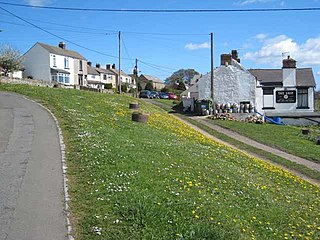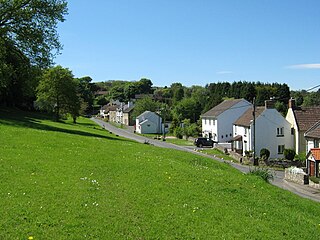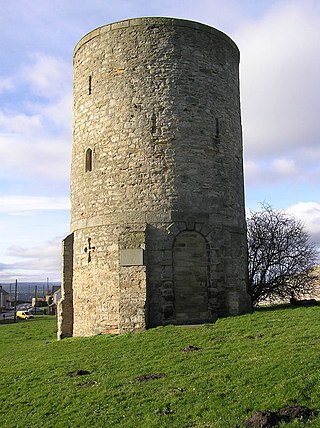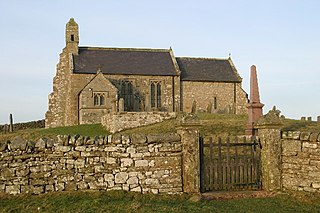
Tanfield is a village and former civil parish, now in the parish of Stanley, in the County Durham district, in the ceremonial county of Durham, England. It is near Stanley, and the location of Tanfield Railway, the Causey Arch and Tanfield School. The village was formerly a mining village.

Sedgefield District was, from 1974 to 2009, a local government district and, borough in County Durham, in North East England. It had a population of about 87,000. It was named after Sedgefield, but its largest town was Newton Aycliffe. Other places included Shildon, Ferryhill and Spennymoor.

Spennymoor is a town and civil parish in County Durham, England. It is south of the River Wear and is 7 mi (11 km) south of Durham. The civil parish includes the villages of Kirk Merrington, Middlestone Moor, Byers Green and Tudhoe.

Tudhoe is a village in the civil parish of Spennymoor, in County Durham, England. It lies just outside Spennymoor, a short distance to the west of the Great North Road. Tudhoe lay at the centre of a network of roads: one ran to Durham by way of Sunderland Bridge and Croxdale, another to Kirk Merrington, a third to Bishop Auckland, a fourth to Whitworth and Byers Green, and a fifth across a ford to Brancepeth Castle and village on the far side of the river. All except the Brancepeth road are shown on the 1768 map of County Durham by Thomas Jefferys.

Byers Green is a village and former civil parish, now in the parish of Spennymoor, in the County Durham district, in the ceremonial county of Durham, England. It is situated to the north of Bishop Auckland, between Willington and Spennymoor, and a short distance from the River Wear. It has a population of 672.

Newfield is a village and former civil parish in the County Durham district, in the ceremonial county of Durham, England. It is situated to the south of Willington, near Bishop Auckland. In the 2001 census Newfield had a population of 368.

Middlestone is a village and former civil parish in the County Durham district, in the ceremonial county of Durham, England. It is situated to the south of Spennymoor, near Kirk Merrington. In the 2001 census Middlestone had a population of 67.

Redworth is a village and former civil parish, now in the parish of Heighington in the borough of Darlington and the ceremonial county of Durham, England. It is west of Newton Aycliffe, between Darlington and Shildon. It had 190 residents at the time of the census in 2001. The name Redworth originates from the words Reed Worth, as the area was a large marsh. Redworth is home to Barcelo Redworth Hall, a 4 star hotel, which has been visited by many famous figures, including the England football team. Redworth Wood is filled with protected trees, and even a Stone Age fort, which has been pictured in the Northern Echo.

Elswick is a district and electoral ward of the city and metropolitan borough of Newcastle upon Tyne, in the county of Tyne and Wear, England, 1.9 miles west of the city centre, bordering the River Tyne. Historically in Northumberland, Elswick became part of Newcastle upon Tyne in 1835. Elswick is home to the Newcastle Utilita Arena; and Newcastle College, with approximately 45,000 students.

Howick is a village and former civil parish, now in the parish of Longhoughton, in Northumberland, England, between Boulmer and Craster. It is just inland from the North Sea, into which Howick Burn flows from Howick Hall. In 1951 the parish had a population of 246.
Robert Shafto was a British politician who sat in the House of Commons between 1760 and 1790. He was the likely subject of a famous North East English folk song and nursery rhyme, "Bobby Shafto's Gone to Sea".
Robert Eden Duncombe Shafto of Whitworth Hall, Spennymoor, County Durham, was a British politician. He was Member of Parliament (MP) for the City of Durham from 1804 to 1806. He served as High Sheriff of Durham in 1842.

Robert Shafto, of Whitworth Hall, Spennymoor, County Durham, was a British Tory politician who sat in the House of Commons between 1712 and 1729.

Whitworth Hall Country Park is a parkland based set in 73 acres (300,000 m2) 8 miles (13 km) from Durham in England, which rests on the outskirts of the town of Spennymoor in County Durham.

Spotland is a district of Rochdale in Greater Manchester, England. The Rochdale ward name is Spotland and Falinge. The population of this ward at the 2011 census was 10,805. It lies on the River Spodden, and is the home of Spotland Stadium.

Westerton is a village and former civil parish in the County Durham district, in the ceremonial county of Durham, England. In the 2001 census Westerton had a population of 44. It is situated between Bishop Auckland and Spennymoor. It sits on top of a hill which is one of the highest points in County Durham, and is the location of an observatory built for Thomas Wright, who was the first person to suggest that the Milky Way consisted of a flattened disk of stars. The observatory is known today as "Wright's Folly".

Whitworth Hall which stands in Whitworth Hall Country Park, near Spennymoor, County Durham England, is a country house, formerly the home of the Shafto family and now a hotel. It is a listed building.

Thockrington is a village and former civil parish, now in the parish of Bavington, in Northumberland, England. The village lies about 10 miles (16 km) north of Hexham. In 1951 the parish had a population of 18.
Shafto is a surname. The Shafto family origins can be traced back to the Ffolliot family, who were established by the 14th century at Shafto Crag, Northumberland and adopted the alternative surname of Shafto. The following people have the name Shafto:
















